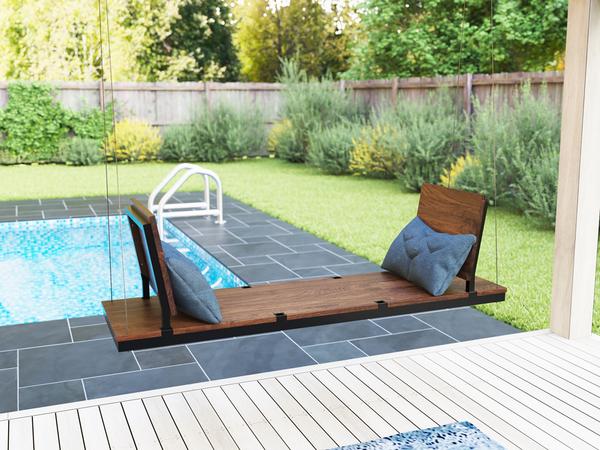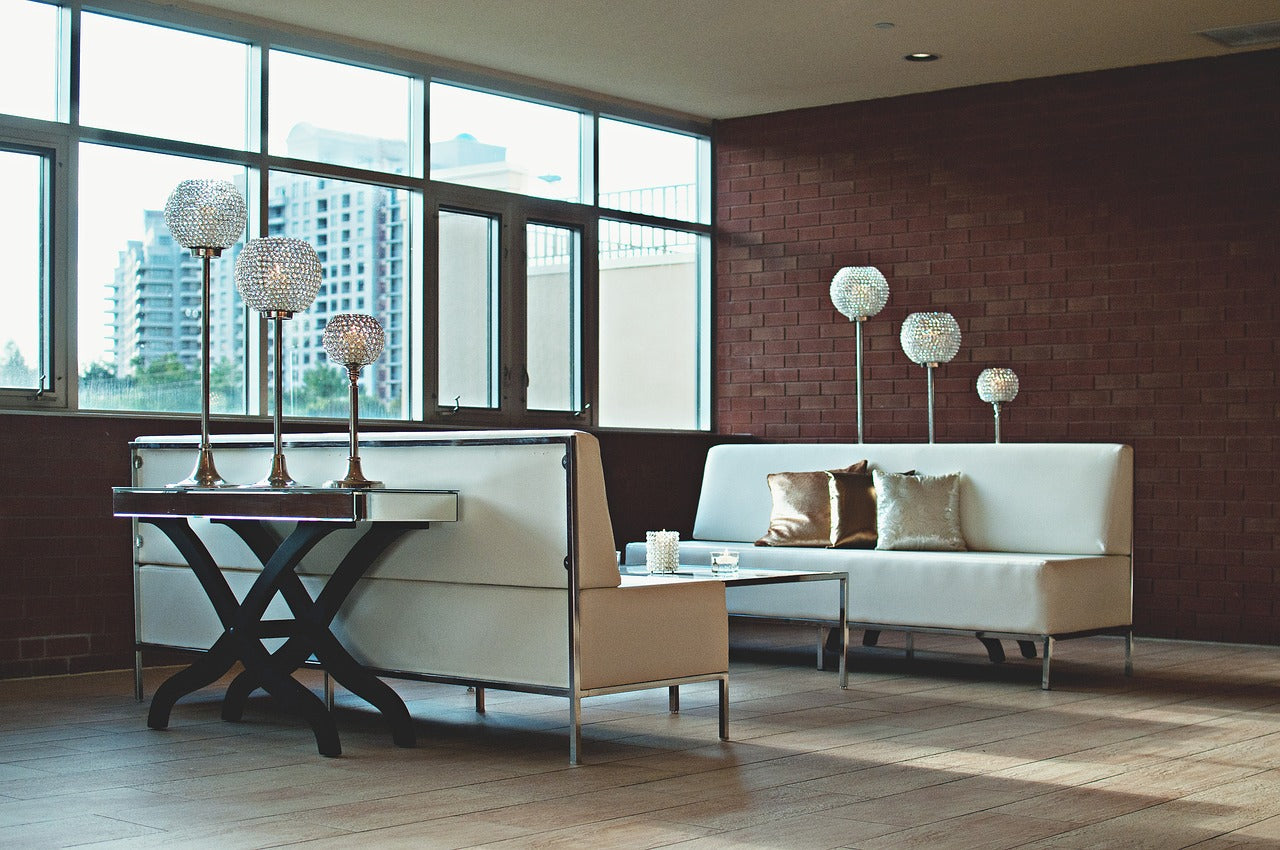
A wooden porch swing is a beloved outdoor furnishing. Swinging in the summer breeze with a glass of sweet tea is an idyllic past time. Why limit the enjoyment to warmer weather months?
Indoor swings bring a sense of playful whimsy to year-round living spaces. Positioned around a fireplace in a cozy den or in a four-seasons sunroom is just the extra touch that makes even the grayest days stuck inside a treasured memory.
Equal parts unexpected and charming, indoor swings are growing in popularity. Whether you’re entertaining guests or looking for a quiet place to flip through your favorite page turner, indoor swings are the ultimate fun-factor furnishing that adds a little dazzle to the everyday.
If you’re looking to infuse a little more fun in your design, here is everything you need to know about hanging an indoor swing.
How to Hang an Indoor Porch Swing

Tools
You don’t need a whole tool room to find what you need to hang an indoor swing. Because every installation is unique, mounting hardware and hanging hooks may not be included in your swing kit. However, the manufacturer will provide guidelines.
For the most part, the tools you need can most likely be found in your house or at a nearby home improvement store.
- Drill
- 3/8-inch bit
- Stud finder
- Measuring tape
- Mounting hardware
- Hanging hooks
It is possible to DIY the job, but having a partner to help with the installation is highly recommended for safety if you don’t choose professional installation.
Step 1: Locate the Ceiling Joists
Hanging an indoor swing requires sturdy ceiling joists for safe installation. Confirming that your joists can support the weight of a hanging swing needs to be your first and foremost consideration. You don’t want to have your heart set on a location before knowing that its structurally sound.
A sturdy ceiling joist is the only support structure that can hold the weight of a hanging swing that people can sit on safely. A joist is a large wood beam that holds the weight of the house. Essentially, a joist is to your ceiling, what a stud is to your wall. Essentially, any weight-bearing object needs to be hung from a joist.
"If you don’t find a solid joist, installers risk attaching the swing mount to a ceiling that cannot support it, or worse—it will pull the ceiling down on the person sitting in the swing," Alan Chenkin, a D.C.-based carpentry expert and Taskrabbit tasker, told House Beautiful all about the swing-hanging process. "If the only spot you have for a swing can't support the load, you have to consider an alternate location.”
In most homes, joists are set in intervals of either 16 inches or 24 inches. A stud finder is the easiest and quickest method for identifying where your joists are located before you commit to a location and start drilling holes.
On average, a ceiling joist can hold up to 50 pounds per square-foot, according to Home On, which is capable of supporting a swing. Chenin also told House Beautiful that you may have to mount a board across the joists to "ensure adequate support for the swing," which would require opening up the ceiling and adding extra support.
"A single person swing should have a mount of 600 pounds capacity or more," Chenkin continued, noting that a double swing requires two mounts.
Look for heavy duty wall plates at your local home improvement store. Bring the installation instructions with you to make sure you're purchasing the mounting plate that is right for your model.
Step 2: Choose a Location with Adequate Space
After locating ceiling joisting, positioning is the next biggest factor for installing a hanging chair indoors.
Of course, you’ll want to select a space where you can put your swing to the best use such as in a den or other shared living space if you intend to use it for entertaining. But for it to be functional, you’ll also need to have adequate room to make sure the swing fits and moves freely without hitting its surroundings.
“Choose a spot that allows for at least three feet of space behind the swing, and at least 14 inches on either side to prevent hitting a wall,” Chenin added.
Step 3: Installation
A good rule of thumb for any DIY home improvement is to measure twice before making cuts or holes. Start by measuring your swing to determine the exact distance between the position hanging hooks. Use a pencil to mark the spots where you’ll secure the hanging hooks to the ceiling.
You’ll have to mount a bench-style indoor swing from two points, spaced a minimum of 64” apart. Hold the first hanging hook against the ceiling, centered on your first mark, and aligned with the joist, recommends Hayneddle.
Then drill pilot holes slightly smaller in diameter than the wood screws. Securely fasten the hanging hook with two screws and hang a comfort spring from the hook. Then attach the chains, cable, or rope to the swing, hanging each side to the ceiling hooks so that the seat is between 18 and 24 inches from the floor.
Step 4: Test Before You Rest
Are indoor swings safe? It is a common question. Like any household product or appliance that is used incorrectly, it can result in injury, but experts say indoor hanging swings are just as safe as their outdoor counterparts.
Test the stability of your swing with the help of a partner to make sure it hangs evenly and swings smoothly. Place a few hardy inanimate objects on the swing prior to sitting on it to ensure it’s firmly in place.
Now, all that's left to do is sit back and enjoy!
Types of Indoor Swings
Indoor swings may be fairly new to mainstream interior design, but their fast-growing popularity have given rise a plethora of style options for every aesthetic. Bench-style indoor swings, hanging chairs, hammock-style swings, and no-mount swings are among the most sought-after. Here is a quick guide to each of the most popular choices on the market.
Bench-Style Swing

Bench-style indoor swing sets are the most classic take on the modern indoor seating arraignment. Bench-style swings invite conviviality during gatherings and relaxation during quiet moments of solace.
The modern Organic Swing is the perfect example of fun and flexibility. The adjustable back allows you to mix it up to create a variety of seating options. Move the seat backs to create a lounger that lets you swing the afternoon away with your feet up. Or you can switch the backs to create a comfortable seating arrangement for two.
Organic Swing's slender steel frame and inlaid cypress boards combine contemporary style and modern versatility that lasts a lifetime. Plus, its durable materials make it great for either indoor or outdoor use.
Dress up the natural wood with oversize cushions and blankets to create a plush and cozy seating area for you and your guests.
Hanging Chair
A hanging chair is a fun way to create a solo-sanctuary as they are best suited for one person — though hanging multiple chairs can make for a festive seating area if you have the space required!
Most hanging chairs only require one anchor point in the ceiling for support; but require at least two-feet on all sides to accommodate the range of motion of an average sized model.
Typically fashioned from wicker, rattan, or rope, hanging chairs give off a distinctively bohemian vibe. Add a pillow and cushion and you may never want to get up.
Hammock-Style Swings

(Photo: Overstock)
Who says hammocks are just for the outdoors? Hammock-style swings are a popular option and come in a variety of colors and patterns to fit your laidback design concept.
One advantage of a hammock is that it naturally distributes its weight evenly so experts say you will only need one anchor point for support. However, there is typically only enough room to fit one person comfortably.
No-Mount Indoor Swings 
(Photo: Lowes)
If your joists are not strong enough to support a swing, you’re still in luck. Indoor swings with stand mounts are available if you’re not interested in drilling holes or if you want the swing seating experience in a rental home.
A porch swing provides the ultimate place for entertaining or slipping away for a quiet moment alone. And the luxury is not just for people with traditional front porches. With Organic Swing, you can enjoy a swing inside the comfort of your home.



